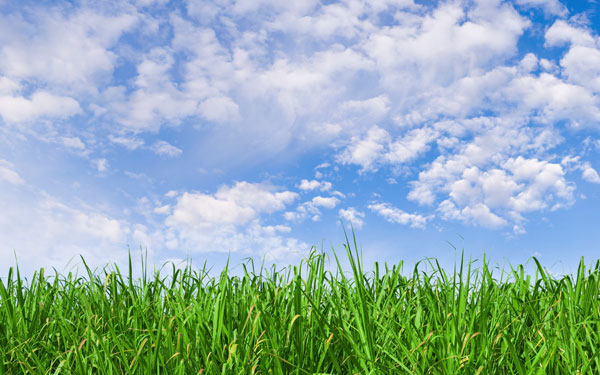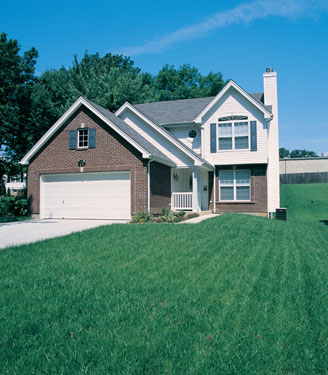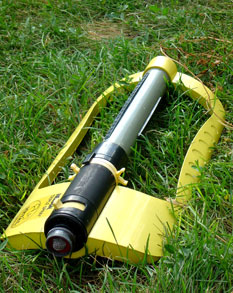 by Kimberly Blackford
by Kimberly Blackford

Who doesn’t want the perfect lawn? A nice spread of soft, green grass is perfect for enjoying the outdoors. It helps muffle traffic noises and reduces carbon dioxide levels. Unfortunately, not every lawn appears to be a healthy green. Many homeowners struggle to keep their grass looking lush and beautiful. Some people automatically decide to drench the ground with chemicals in hope to grow grass and kill weeds. However, chemical lawn fertilizers can repel healthy earthworms, kill soil microbes and ruin the soil composition. Organic lawn care produces the desired results without the use of harmful products. Treating your lawn organically is low in cost, healthier for the environment and continues to improve your grass year after year.

View This House Plan to the left
View Other Traditional House Plans
There are many reasons for the lack of healthy, green grass in your lawn. Mowing the grass too short and improper watering and fertilizing are a few causes of an unhealthy lawn. Poor soil compaction and shaded areas also contribute to weak grass. Similar to all living things, grass needs nutrients to survive. Chemically treated lawns often rely on multiple applications and can deteriorate the strength of the grass. Since the grass plant relies on the soil as its food source, it is important to supply the soil with healthy nutrients. Organic lawns are self-sufficient and support proper soil vigor that plays a crucial part in maintaining the color and endurance of green grass.
An excellent starting point is to have your soil tested. Some university students will do the testing for you, often free of charge, or you can purchase an inexpensive testing kit at a garden supply store. Most grass plants flourish best with a pH between 6.5 and 7. This range is considered a neutral to slightly acidic environment. If your soil’s pH is below 6.5, you can increase its acidity by sprinkling sand or used tea bags into the soil. For soil above a pH of 7, add a lime-based product or compost coffee grounds to lower the alkaline levels. Healthy soil will grow healthy grass.

Nitrogen is a very important nutrient for your lawn. Yellow grass is a result of a lawn lacking in nitrogen. It is essential in building chlorophyll proteins and provides grass with the beautiful green color. Nitrogen represents the first of the three numbers when purchasing fertilizer. Organic, slow-release fertilizers feed your lawn and soil over a longer period of time by breaking down slowly. There are also many organic methods that can increase the nitrogen in your lawn, like leaving grass clippings on the lawn after you mow. Mulching the grass clippings and spreading them on the lawn will attract earthworms, aerate the soil and reduce soil compaction. A bit of clover in your lawn fixes nitrogen from the air, attracts earthworms, stays a pretty green color and is drought tolerant. Alfalfa meal, chicken manure, corn gluten, soybean meal and composted organic materials from your own kitchen are other effective ways to introduce nitrates into the soil. Spread an inch of compost on your lawn in the fall and water it into the soil to build up the organic matter. Soon your organic lawn will be established and natural nutrient cycling in the soil will support sustainability of nutrients. The soil’s ability to hold water will dramatically increase by adding organic matter to your lawn as well. All of these suggestions will help produce nutrients to grow healthy grass cost effectively and without using harsh chemicals.

View This House Plan
View Other Southern House Plans
Aerate your lawn every few years to allow water, air and nutrients to penetrate the roots.
Inexpensive aerating sandals look like plastic sandals with spikes on the bottom to open the surface of the soil and allow water to penetrate the roots. This helps the water to carry lime and other nutrients straight to the roots of the grass.

Proper watering is essential for a healthy lawn. In order to thrive, most lawns need about one inch of water per week. Use a rain gauge or tin can to measure the amount of rainfall to see if your lawn is getting enough water. Watering deeply but infrequently will penetrate and promote strong roots. Some people water the lawn in the evening to increase absorption into the ground. Others water early in the morning to avoid evaporation before the heat of the day and prevent disease. After watering, check the soil moisture by using a garden trowel. Keep watering if your soil is not wet four to six inches down to promote healthy, deep grass roots.
 Regular mowing will also help keep your lawn a pretty green color. Hand reel mowers are quiet, start when you do and provide the perfect clean cutting action that is healthiest for your grass. Rotary gas mowers can tear at the turf causing damage to the lawn. Keep your grass cut high and never cut more than two inches at a time. To avoid traumatizing the lawn, try to avoid cutting more than one-third of the grass blade. Sharp mower blades help give an even cut to the grass and avoid lawn diseases. To help your grass grow straight, mow in different directions each time. In order to prevent disease and an uneven cut, only mow when your grass is dry.
Regular mowing will also help keep your lawn a pretty green color. Hand reel mowers are quiet, start when you do and provide the perfect clean cutting action that is healthiest for your grass. Rotary gas mowers can tear at the turf causing damage to the lawn. Keep your grass cut high and never cut more than two inches at a time. To avoid traumatizing the lawn, try to avoid cutting more than one-third of the grass blade. Sharp mower blades help give an even cut to the grass and avoid lawn diseases. To help your grass grow straight, mow in different directions each time. In order to prevent disease and an uneven cut, only mow when your grass is dry.

While having a weed-free yard is practically impossible, weed control in necessary for a green lawn. A healthy lawn will have a few weeds, however, do take care to keep the weeds from producing seeds. Since it is much easier to control a few young weeds than a whole lawn full, try to fight weed problems early. Cutting down on the number of weed seeds in the yard will prevent more from growing. If you find a large amount of weeds, manually pull them out with the roots, reduce watering and let your grass grow higher. Remember to be persistent with dandelions by repeatedly removing their flowers, leaves and root if possible. Adding corn gluten meal helps prevent weed seeds from germinating and adds healthy nitrogen to the soil.
Healthy, green grass is no longer a dream, but a reality. Tending to an organic lawn is more cost effective and healthier for the environment. There is no need to be an expert on horticulture to have green grass. With a little time and care, every homeowner can have a healthier, greener lawn. Plus, it is greatly beneficial to choose the greener way to a green up your yard.

View This House Plan
View Other Ranch House Plans
Here are some related articles:
Save this article to:
back to top